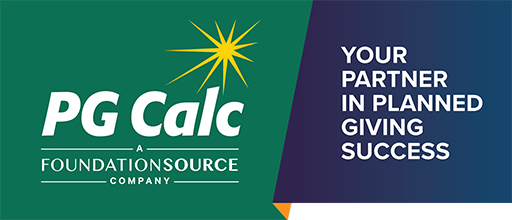Featured Articles
PG Calc publishes monthly articles on the latest topics in planned giving.
IRS Statistics on Planned Gifts Reveal Some Surprises
-Have you wondered what role charitable remainder trusts, charitable lead trusts, and pooled income funds play in fundraising nationwide? Have you wondered how much organizations like yours typically benefit from these gifts? Have you wondered how many of each are in place across the country? You can answer these and many other questions about these gift arrangements by visiting the IRS website.
Gifts of Gold
-Many people invest in gold. Their motivations may vary, but the important reality is that your organization likely has numerous supporters with substantial holdings of gold. In many cases, these supporters could make an excellent charitable gift with some or all of their gold. There are, however, several special considerations to be aware of when discussing a gift of gold with a donor.
Endowments Enable Planned Gifts to Cast a Long Shadow
-Endowments are a long-term proposition. Similarly, planned gifts often have a long-term aspect to them in that the wealth being transferred by donors in all likelihood took many years to amass. Frequently as well, donors want their gifts to have an enduring impact.
All in all, even though planned gifts and endowments are ultimately distinct, planned gifts are generally well-suited for bolstering endowments, and many planned gifts do in fact wind up playing that role. Furthermore, a planned giving program can provide a “home” for endowment activities. It is not uncommon for development officers responsible for planned giving also to be charged with directing, or at least assisting, endowment efforts.
Gift Annuities - Year-end Planning and Operations
-The responsibility for gift administration may be in-house or the charity may rely on a service provider to meet the many and varied requirements in fulfilling commitments to donors and beneficiaries of charitable gift annuities. Either way, the so-called “buck stops here” rests with the charity. Donors look to the charity to provide timely and accurate stewardship of their gifts no matter who performs the actual work.
This is the time when it all comes together, or should! Between December and early April the administration and reporting requirements peak.
It’s a Great Time to Consider a Retained Life Estate
-For many donors, their home is their most valuable asset. They most likely plan to live there for many years and it would never occur to them that they could use their home to make a charitable gift. Likewise, there are many donors with a valuable second home that they continue to use regularly and have never considered giving to charity. In both cases, the retained life estate may offer the key to unlocking just such a gift.
Gift Planning in a Nervous Market
-In 2009, the financial crisis was in its infancy, the stock market was plunging, and no one was sure where it would all end. In response, PG Calc staff devoted substantial energy to analyzing and discussing with our clients gift planning in a down economy. Six years later, most donors no longer fear that we may be entering an economic depression, but the financial markets remain volatile and many donors remain nervous about their financial futures.
Appreciating Residual Bequests
-Some bequests are more equal than others. Although the terminology may vary a bit, there are basically three different types of bequests: pecuniary (in which a sum of money is given), specific (in which a particular asset is given), and residual (in which all or a portion of the donor’s estate is given after taking into account pecuniary and specific bequests, along with the payment of debts and expenses of the estate).
Many seasoned institutional gift planners are partial to residual bequests.
Common Recommendations from Our Consulting Audits
-PG Calc is a pretty exciting place to work – especially if you like projects as interesting as reviewing planned giving programs of every size, shape, and maturity. We are often asked to uncover key problems that hinder the effectiveness of planned giving efforts. This article outlines a few of the more common recommendations that we give to clients. While it’s clear that all of these problems rarely exist in one place, the four categories of recommendations are the recurring themes.
Discouraging Bad Gifts
-A bad gift can be defined as one that leaves a charity worse off than if no gift had been made. Some gift planners might argue that even a gift that produces some benefit for the charity can still be a bad one if either (1) dealing with it draws heavily upon resources that would clearly be better devoted to other gifts or (2) the gift simply results in a lot of headaches and hassle.
Anyone who has been involved with a bad gift is loath to repeat the experience if at all possible. Fortunately, adopting – and adhering to – sound gift acceptance policies can go a long way toward helping a charity avoid bad gifts.
Computing the Value of a Future Bequest
-We are asked regularly by clients for help estimating the value of a known bequest intention that will occur at some unknown time in the future, when the donor dies. There are two common approaches to making this determination, the life expectancy approach and the mortality approach.

